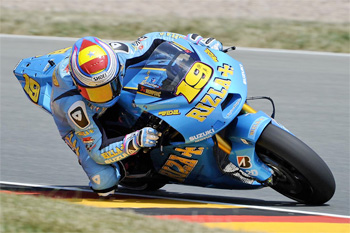
Suzuki's MotoGP effort can now use up to nine engines instead of six after the GP Commission revised regulations.
The Grand Prix Commission met at the Brno round of the MotoGP World Championship in the Czech Republic last weekend, confirming a number of regulation revisions.
Teams who have won less than two dry races in the last two years – only Suzuki – will be permitted nine engines instead of the limit of six, a ruling that will also be an advantage to new teams entering the series.
The Aragon round of the series will feature two 45-minute practices on Friday instead of the usual hour-long single session, and that is expected to be introduced fulltime for 2011.
When the production bike-based 1000cc Claiming Rule Teams (CRTs) are permitted in 2012, the commission clarified that only non-factory teams will be eligible for 12 engines and 24-litre fuel tanks compared to the six engines and 21-litre tanks that the factory ‘prototype’ teams will be permitted to use.
In a clarification on previous regulations announced, the GP Commission will have to approve what teams are eligible to be ranked as CRTs and also have the right to transfer any team to a ‘prototype’ team during the season in a bid to stop the factories running full-factory CRTs – effectively restricting their engine allocation and tank sizes for the remainder of the year.
It was also confirmed that the 125GP category will be replaced by a Moto3 class in 2012, the class to feature a 250cc single-cylinder four-stroke engine with a maximum bore of 81mm. Unlike Moto2, the Moto3 class will not feature a control engine manufacturer, however any manufacturer building a Moto3 engine must sell it for under 3000 Euros and be prepared to supply the engine to at least 15 riders if required.







Newsletter